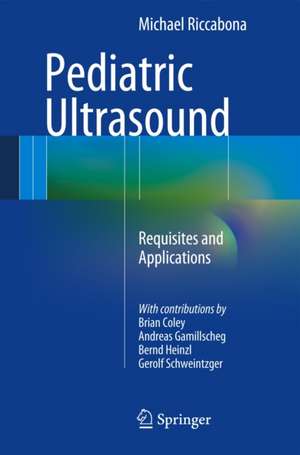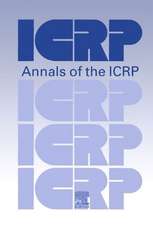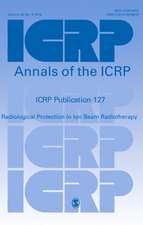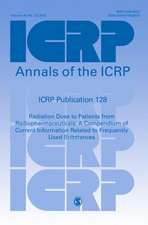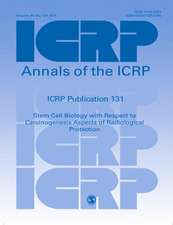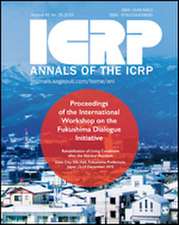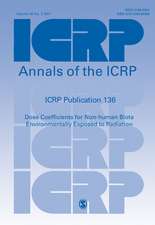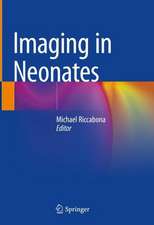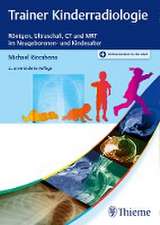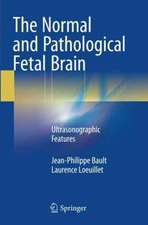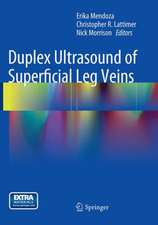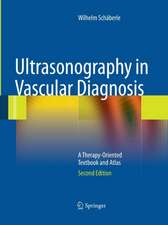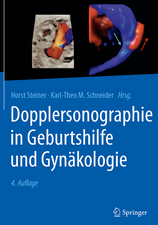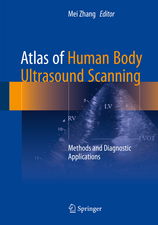Pediatric Ultrasound: Requisites and Applications
Autor Michael Riccabona Contribuţii de Brian Coley, Andreas Gamillscheg, Bernd Heinzl, Gerolf Schweintzgeren Limba Engleză Paperback – 16 apr 2014
Pediatric Ultrasoundwill prove an indispensable source of information for radiology residents, experienced (pediatric) radiologists, sonographers, pediatricians, and all other physicians who deal with children in their daily practice.
| Toate formatele și edițiile | Preț | Express |
|---|---|---|
| Paperback (2) | 1002.57 lei 38-44 zile | |
| Springer Berlin, Heidelberg – 16 apr 2014 | 1016.14 lei 3-5 săpt. | |
| Springer International Publishing – 16 oct 2020 | 1002.57 lei 38-44 zile |
Preț: 1016.14 lei
Preț vechi: 1069.61 lei
-5% Nou
Puncte Express: 1524
Preț estimativ în valută:
194.49€ • 202.70$ • 161.90£
194.49€ • 202.70$ • 161.90£
Carte disponibilă
Livrare economică 14-28 decembrie
Preluare comenzi: 021 569.72.76
Specificații
ISBN-13: 9783642391552
ISBN-10: 3642391559
Pagini: 350
Ilustrații: 347 illus., 152 illus. in color
Dimensiuni: 155 x 235 x 25 mm
Greutate: 0.79 kg
Ediția:2014
Editura: Springer Berlin, Heidelberg
Colecția Springer
Locul publicării:Berlin, Heidelberg, Germany
ISBN-10: 3642391559
Pagini: 350
Ilustrații: 347 illus., 152 illus. in color
Dimensiuni: 155 x 235 x 25 mm
Greutate: 0.79 kg
Ediția:2014
Editura: Springer Berlin, Heidelberg
Colecția Springer
Locul publicării:Berlin, Heidelberg, Germany
Public țintă
Professional/practitionerCuprins
Basics:
Physics
of
diagnostic
ultrasound
(US).
US
techniques.
Artifacts.
Biological
effects
of
US.
Practical
US
approach.
Documentation
and
reporting.
Future
US
methods.
Basics
of
(Color)
Doppler
sonography.-
Diagnostic
flow
charts,
imaging
algorithms,
and
graphs:
Urinary
tract
diseases.
Tumors
and
oncology.
Abdomen.
Systemic
diseases.
Graphs
and
illustrations
for
standardized
measurements
and
volume
calculations.-
US
investigations
of
various
organs
and
systems:
Pediatric
cranial
neurosonography.
US
of
the
neonatal
spinal
cord.
Neck
and
facial/cervical
glands.
Chest
US.
Basics
of
pediatric
and
neonatal
echocardiography.
Abdominal
US.
Musculoskeletal
and
other
small
part
US.
US-guided
interventions.
Textul de pe ultima copertă
Ultrasound
plays
an
important
role
in
the
diagnostic
imaging
of
infants
and
children
and
has
indeed
become
the
workhorse
for
many
conditions.
This
is
attributable
both
to
the
avoidance
of
ionizing
radiation
and
to
the
unique
features
displayed
on
ultrasound
in
children
in
almost
all
body
areas.
In
the
future
the
potential
of
ultrasound
can
be
expected
to
increase
further
owing
to
new
developments
such
as
ultrasound
contrast
material,
three-
or
four-dimensional
ultrasound,
and
ultrasound
elastography.
This book systematically covers the use of ultrasound in all organ systems and throughout childhood. After discussion of the basics, including physics, artifacts, and procedural details, decision making regarding the use of ultrasound is elucidated by listing next imaging steps based on recommended imaging algorithms. The indications and prerequisites for a particular examination are documented, and practical tips and tricks are highlighted. The normal, age-dependent ultrasound findings and typical appearances in different pathologies are presented in detail and illustrated by numerous high-quality images. Particular emphasis is placed on those findings that differ from the adult sonographic appearances. In addition to the classic pediatric abdominal applications, detailed consideration is given to neurosonography, echocardiography, chest ultrasound, musculoskeletal and hip ultrasound, Doppler sonography, and interventional ultrasound. The potential role of the most modern techniques in various situations is explained.
Pediatric Ultrasoundwill prove an invaluable source of information and an indispensable aid to decision making and diagnosis for radiology residents, experienced (pediatric) radiologists, sonographers, pediatricians, pediatric surgeons and urologists, and all other physicians who deal with children as a part of their daily practice.
This book systematically covers the use of ultrasound in all organ systems and throughout childhood. After discussion of the basics, including physics, artifacts, and procedural details, decision making regarding the use of ultrasound is elucidated by listing next imaging steps based on recommended imaging algorithms. The indications and prerequisites for a particular examination are documented, and practical tips and tricks are highlighted. The normal, age-dependent ultrasound findings and typical appearances in different pathologies are presented in detail and illustrated by numerous high-quality images. Particular emphasis is placed on those findings that differ from the adult sonographic appearances. In addition to the classic pediatric abdominal applications, detailed consideration is given to neurosonography, echocardiography, chest ultrasound, musculoskeletal and hip ultrasound, Doppler sonography, and interventional ultrasound. The potential role of the most modern techniques in various situations is explained.
Pediatric Ultrasoundwill prove an invaluable source of information and an indispensable aid to decision making and diagnosis for radiology residents, experienced (pediatric) radiologists, sonographers, pediatricians, pediatric surgeons and urologists, and all other physicians who deal with children as a part of their daily practice.
Caracteristici
Systematically
covers
the
use
of
ultrasound
in
all
organ
systems
and
throughout
childhood
Presents the normal, age-dependent findings and typical appearances in a wide range of pathologies, with the aid of numerous high-quality images
Highlights differences from ultrasound findings in adults
Clearly explains the role of the most modern techniques
Presents the normal, age-dependent findings and typical appearances in a wide range of pathologies, with the aid of numerous high-quality images
Highlights differences from ultrasound findings in adults
Clearly explains the role of the most modern techniques
Notă biografică
Michael Riccabona, MD, works at the Department of Radiology’s Division of Pediatric Radiology at the University Hospital Graz, Austria.
Prof. Riccabona was the president of ESPR in 2015 and is now an honorary member of ESPR. He is also a fellow of AIUM and a past president of the society of German-speaking pediatric radiologists (GPR). He is chair of the pediatric section of the Austrian Ultrasound Society (OEGUM) and the Austrian Radiological Society (OERG). He has and is engaged in numerous teaching activities throughout the world, particularly also in outreach settings.
Prof. Riccabona was the president of ESPR in 2015 and is now an honorary member of ESPR. He is also a fellow of AIUM and a past president of the society of German-speaking pediatric radiologists (GPR). He is chair of the pediatric section of the Austrian Ultrasound Society (OEGUM) and the Austrian Radiological Society (OERG). He has and is engaged in numerous teaching activities throughout the world, particularly also in outreach settings.
